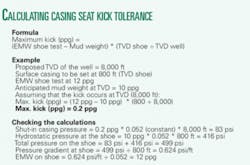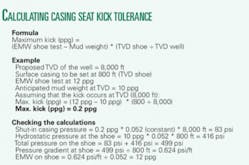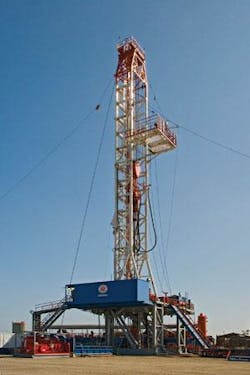Safe drilling practices include thoroughly planning an appropriate casing program to reach TD without mishap. Planning for intermediate casing strings can reduce consequences when overpressured formations are suspected.
Santa Barbara
On Jan. 28, 1969, an event on Union Oil’s Alpha platform in the Santa Barbara Channel permanently changed the oil and gas industry. While tripping pipe out of the hole from a depth of 3,500 ft, Well A-21 blew out.1 The subsequent oil spill and ecological disaster sent tremors through the industry that are still being felt today. Few events prior to this date have had such far-reaching consequences for the industry.
Following the Santa Barbara Channel blowout, the Railroad Commission of Texas held hearings in Austin to determine what measures, if any, should be adopted to prevent a similar occurrence in Texas.
There were several points of failure that contributed to the Santa Barbara Channel blowout. One of the factors discussed at the hearings concerned the amount of casing that was set. Union Oil had been granted an exemption by the US Geological Survey that allowed the company to set less casing than was required by federal standards.
10% case exemption
Exemptions to casing standards are not uncommon and there was some testimony at the hearings on this issue. The consensus opinion was that allowing an amount of surface casing equal to 10% of the proposed total vertical depth of a well is reasonable.
Although there are many wells in which 10% surface casing will provide an ample safety factor insofar as well control is concerned, it is certainly not adequate in all situations. Each well must be considered to determine whether minimal casing is appropriate. Therefore, one must examine the wellbore dynamics that occur when a kick takes place.
Potential problems
Killing the well after taking a kick is contingent upon being able to circulate heavier mud into the wellbore under controlled conditions. If the fracture gradient of the casing seat is exceeded, several negative consequences could occur:
- Loss of circulation that would make placing heavier mud in the wellbore more difficult.
- A drop in the mud level in the annulus that would cause formations just below the surface casing to collapse into the wellbore and enable other formations to feed into the wellbore.
- Sands containing usable quality water and productive formations not covered by surface casing could be damaged.
- Possible extension of the fracture to the surface, compromising the safety of drilling operations and causing ecological damage, as in the Santa Barbara Channel event.
Analysis
Our analysis is confined to kicks from a penetrated formation that has greater pore pressure than hydrostatic mud pressure in the wellbore.
The formula for casing seat kick tolerance is:
A practical example appears in the accompanying box.
Obviously, serious well control problems can occur if it is believed that the 8,000-ft well in this example is capable of withstanding a 2-ppg kick (EMW shoe test mud weight). That assumption is incorrect by a factor of 10.
Simply stated, the casing seat kick tolerance on a well having 10% surface casing is 10% of the difference between the EMW shoe test and the mud weight at total vertical depth, if the kick occurs at total vertical depth. It is worth noting that if the casing seat in this example had been tested to 13 ppg, the kick tolerance would increase from 0.2 ppg to 0.3 ppg.
The accompanying table shows various combinations of criteria and the kick tolerance associated with each situation if the kick occurs at total vertical depth. Increasing the amount of surface casing clearly increases the casing seat kick tolerance.
Setting additional surface casing, however, may offer a false sense of security if one does not examine the limitations of the particular situation. In the examples shown, setting 30% surface casing instead of 10% increased the kick tolerance threefold. And yet, none of the situations resulted in a kick tolerance greater than 0.9 ppg.
Intermediate strings
Wells that are planned to include an intermediate string of casing to be set once an abnormal pressure zone has been encountered are often less dangerous than those for which such casing has been considered unnecessary. During drilling, the depth at which intermediate casing is to be set is often changed, based on indicators signaling the severity of the transition zone (mud properties, penetration rate, gas, cuttings analysis, borehole stability, etc.).
If a pressure transition zone is encountered on a well that incorporates only surface casing, however, the operator may face some difficult choices:
- Conclude drilling at a shallower depth than was originally planned.
- Set small-diameter intermediate casing. Under this scenario, the well costs will greatly exceed the original AFE estimate and the operator will be forced to work with an intermediate situation with potentially undesirable well dimensions.
- Ignore the indicators and try to force the well deeper into the transition zone to reach the planned total depth without setting intermediate casing. If unsuccessful, the consequences could be disastrous.
The best way to handle this kind of well control situation is to plan the well so as to avoid taking such a kick. There is no substitute for accurate information and careful planning. This is especially true when setting a minimal amount of surface casing on a well that may encounter an abnormally pressured formation before reaching total depth.
Reference
- Clarke, K.C., and Hemphill, Jeffrey J., “The Santa Barbara Oil Spill, A Retrospective,” Yearbook of the Association of Pacific Coast Geographers, Vol. 64, pp. 157-162, University of Hawaii Press, 2002.
The authors
Fermin Munoz Jr. ([email protected]) is a geologist and District 4 director in the oil and gas division of the Railroad Commission of Texas. He began working as a mud logger in the Bay of Campeche, then joined the Texas RRC in Houston, followed by a period working as an exploration geologist for Huffco Petroleum in Corpus Christi, Tex. In 1983, he rejoined the RRC as District 4 director. Munoz received a BA (1978) in geology from Texas A&I University, Kingsville. He is a licensed geologist in Texas and a certified petroleum geologist (American Association of Petroleum Geologists).
Gary Judd ([email protected]) is a senior account representative at Ambar Lone Star Fluid Services, a subsidiary of Patterson-UTI Energy Inc., based in Corpus Christi, Tex. He has also served as district engineer for Halliburton Services, senior operations engineer for Mobil Oil Corp., district drilling engineer for Texas Oil and Gas Corp., president of Padre Drilling Co., and area manager for Patterson-UTI Drilling Co. Judd holds a BS (1970) in agricultural engineering from Texas Tech University, Lubbock.






